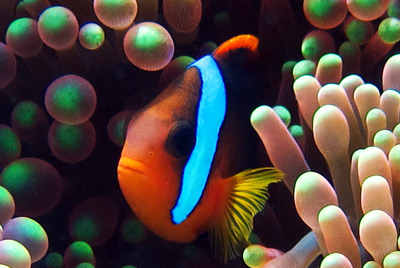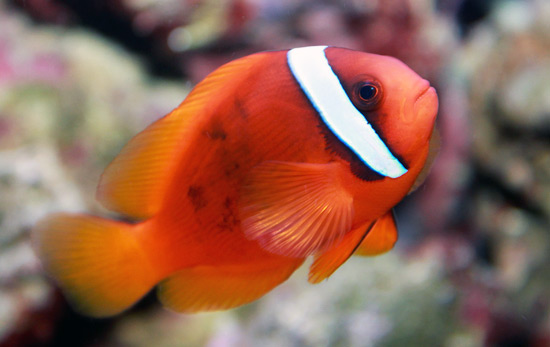Lately it seems many of the species profiles I’ve written have been on fish that either grow too large for the average home aquarium or are otherwise poor choices for aquarium keeping for one reason or another. By now, some of you salties out there might be wondering, “Does this guy ever write about species that can actually be kept in a home aquarium?”
So, for today’s post, I’d like to highlight a fish that is not only attractive, but also hardy to the point of being “bulletproof” (especially if you acquire a captive-bred specimen), very easy to feed, and well suited to medium-sized systems. I’m talking about the tomato clownfish (Amphiprion frenatus), which hales from the western Pacific.
Physical traits
A. frenatus has a robust, ovoid body that is orange-red to tomato-red in overall coloration. Just behind the eye is a vertical white bar. Females are larger than males and exhibit a charcoal coloration on their flanks with age. Juveniles are yellowish-orange and have a second white bar at mid-body that disappears as they mature.
Size-wise, this clownfish can reach upwards of five inches, though most captive specimens won’t grow that large. The one that has been residing in my 125-gallon FOWLR tank for the past eight years is only about three inches long.
Feeding
No challenge here! This clown will accept just about any suitably sized foods presented, even dry pellets and flakes. Be sure to offer a variety of meaty and algae-based foods to satisfy its omnivorous diet. I feed my specimen three times daily and wouldn’t recommend feeding less than twice a day.
Is an anemone necessary?
In nature, A. frenatus associates with Entacmaea quadricolor, the bubble-tip anemone. However, it will do absolutely fine in captivity sans a host anemone. The good news is, E. quadricolor is about the easiest clownfish-hosting anemone to maintain in aquariums, so an experienced hobbyist could certainly set up a tank that showcases this fascinating symbiosis.
Housing
With respect to tank size, I wouldn’t go any smaller than 30 gallons for this species. Keep in mind that A. frenatus is moderately aggressive, and the smaller the tank in which you try to contain that aggression, the harder life will tend to be for any tankmates.
Compatibility
To elaborate on that aggressiveness, similar-looking and smaller, more peaceful species are likely to elicit hostility from A. frenatus. Conspecifics are also best avoided unless you have a mated pair. Otherwise, larger, assertive species that are dissimilar in appearance are usually safe choices. Some territorial squabbling may still occur in this case, but it will usually be mild and short-lived. Again, the larger the tank, the less likely that territorial aggression will prove to be a major issue.
My specimen currently cohabitates with the following lineup of tankmates:
- A pair of blue-chin triggers (Xanthichthys auromarginatus)
- 1 yellow tang (Zebrasoma flavescens)
- 1 onespot foxface (Siganus unimaculatus)
- 1 sixline wrasse (Pseudocheilinus hexataenia)
The only tankmate that tends to elicit aggression from the clown is the sixline wrasse, but the wrasse is so quick and maneuverable compared to the clown that it can easily escape through the rockwork to another part of the tank if threatened. The clown will also very occasionally square off with the tang, but these encounters are infrequent, very brief, and mostly bluster. Neither specimen has ever injured the other in any way.
Reef friendliness
A. frenatus is generally an excellent choice for suitably sized reef systems, but with one caveat. Like any clownfish, it may adopt another fleshy sessile invertebrate, such as a large-polyp stony coral, as a surrogate host. In some cases, this can irritate the invertebrate to the extent that it will refuse to expand its tissues, potentially preventing it from getting adequate light. If you observe this type of interaction and it seems to be persisting, it may become necessary to remove the clownfish.




